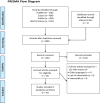Guillain-Barré syndrome in association with COVID-19 vaccination: a systematic review
- PMID: 36098903
- PMCID: PMC9469827
- DOI: 10.1007/s12026-022-09316-6
Guillain-Barré syndrome in association with COVID-19 vaccination: a systematic review
Abstract
Since the beginning of worldwide vaccination against coronavirus disease 2019 (COVID-19), studies have reported a possible association between vaccination and Guillain-Barré syndrome (GBS). In this regard, we conducted a systematic review assessing different demographic, clinical, and neurophysiological aspects of patients with GBS following immunization with COVID-19 vaccines. A comprehensive search of PubMed, Web of Science, Scopus, and Google Scholar was performed. Articles in English between January 2020 and November 2021 were included. Data on demographics, clinical characteristics, vaccines information, treatment approaches, and outcomes were extracted. The data of a total of 88 patients out of 41 studies was included. The mean age of patients was 58.7 ± 16.6 years and 55 cases (62.5%) were male. AstraZeneca was the most-reported vaccine associated with GBS with 52 cases (59.1%) followed by Pfizer with 20 cases (22.7%). GBS occurred after the first dose of vaccination in 70 cases (79.5%). The mean time interval between vaccination and symptom onset was 13.9 ± 7.4 days. Limb weakness (47.7%), sensory disturbance (38.6%), and facial weakness (27.3%) were the most common reported symptoms, respectively. Albuminocytologic dissociation was seen in 65% of patients who underwent lumbar puncture (n = 65). Acute inflammatory demyelinating polyradiculopathy was the most common GBS subtype, which was reported in 38 patients (43.2%). While one-fifth of patients underwent intubation (n = 17), a favorable outcome was achieved in the majority of subjects (n = 46, 63%). Overall, a small rise in GBS incidence, following various COVID-19 vaccines, was observed. Notably, 85% of affected individuals experienced at least a partial recovery.
Keywords: COVID-19; Guillain-Barré syndrome; SARS-COV-2; Vaccination.
© 2022. The Author(s), under exclusive licence to Springer Science+Business Media, LLC, part of Springer Nature.
Conflict of interest statement
The authors declare no competing interests.
References
Publication types
MeSH terms
Substances
LinkOut - more resources
Full Text Sources
Medical
Miscellaneous


